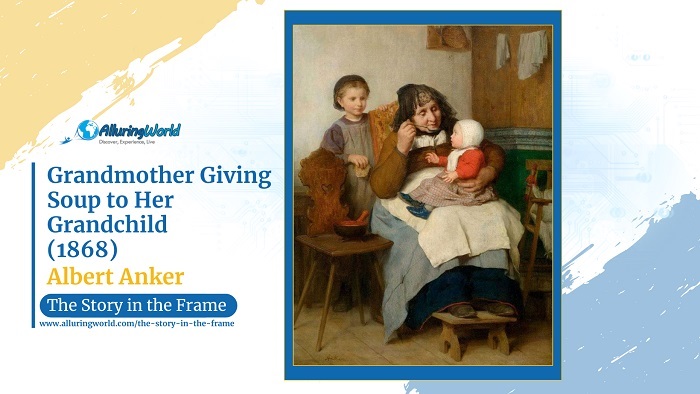Grandmother Giving Soup to Her Grandchild by Albert Anker is a heartwarming painting depicting a family life and intergenerational care which was painted in 1868 and it captures a simple yet deeply meaningful moment between a grandmother and her young grandchild, emphasizing themes of love, nurture, and the warmth of home. As Anker is known for his detailed portrayals of everyday rural life in Switzerland, he certainly brings tenderness and authenticity to this work, celebrating the quiet beauty of domestic scenes.
About the Painter:
Albert Anker (1831–1910) was a Swiss painter renowned for his realistic and sentimental depictions of peasant life. Often called the national painter of Switzerland, he had a profound appreciation for traditional Swiss culture, frequently illustrating scenes of family, childhood, and education. His paintings are characterized by careful attention to detail, warm color palettes, and an ability to evoke a sense of nostalgia, so his work played a crucial role in preserving the rural Swiss way of life through art, making his pieces both culturally significant and universally relatable.
Inspiration and Reasons Behind the Painting:
Anker’s paintings often centered on themes of family bonds, rural traditions, and the simplicity of everyday life. He was deeply influenced by the values of his time, where family and intergenerational relationships were the foundation of society, so Grandmother Giving Soup to Her Grandchild likely reflects his admiration for the role of elders in raising and caring for younger generations. The painting is a definite tribute to the wisdom, patience, and nurturing spirit of grandparents, highlighting the continuity of care within a family.
What is Depicted in the Painting:
The painting presents a cozy domestic scene where an elderly woman who gently feeds a young child is observed over her right shoulder by an older one. The setting is modest yet inviting, possibly a rustic kitchen or dining area with simple furniture and everyday household items, and the grandmother’s expression conveys warmth and patience, while the child appears focused, perhaps showing a mix of curiosity and trust. The surroundings, with their carefully arranged objects, add to the authenticity of the moment, grounding the scene in the quiet rhythms of home life, but the presence of natural light and soft details further enhance the sense of warmth and intimacy.
Colors and Techniques:
Anker’s color palette is typically warm and earthy, using tones of brown, beige, and ochre to create a natural and inviting atmosphere, and the soft interplay of light and shadow brings depth to the composition, highlighting the figures while maintaining a sense of realism. His brushwork is precise, emphasizing the textures of fabric, wood, and skin to enhance the lifelike quality of the painting, and the careful rendering of facial expressions and body language adds to the emotional depth, making the scene feel intimate and authentic.
Conclusion:
In conclusion, Grandmother Giving Soup to Her Grandchild is a touching portrayal of love, care, and tradition, embodying Albert Anker’s dedication to capturing the essence of family life. The painting serves as a timeless reminder of the simple yet profound moments that shape childhood and the vital role grandparents play in nurturing future generations, so even today, it continues to resonate with audiences, offering a nostalgic glimpse into the enduring bonds of family and the universal nature of caregiving.

